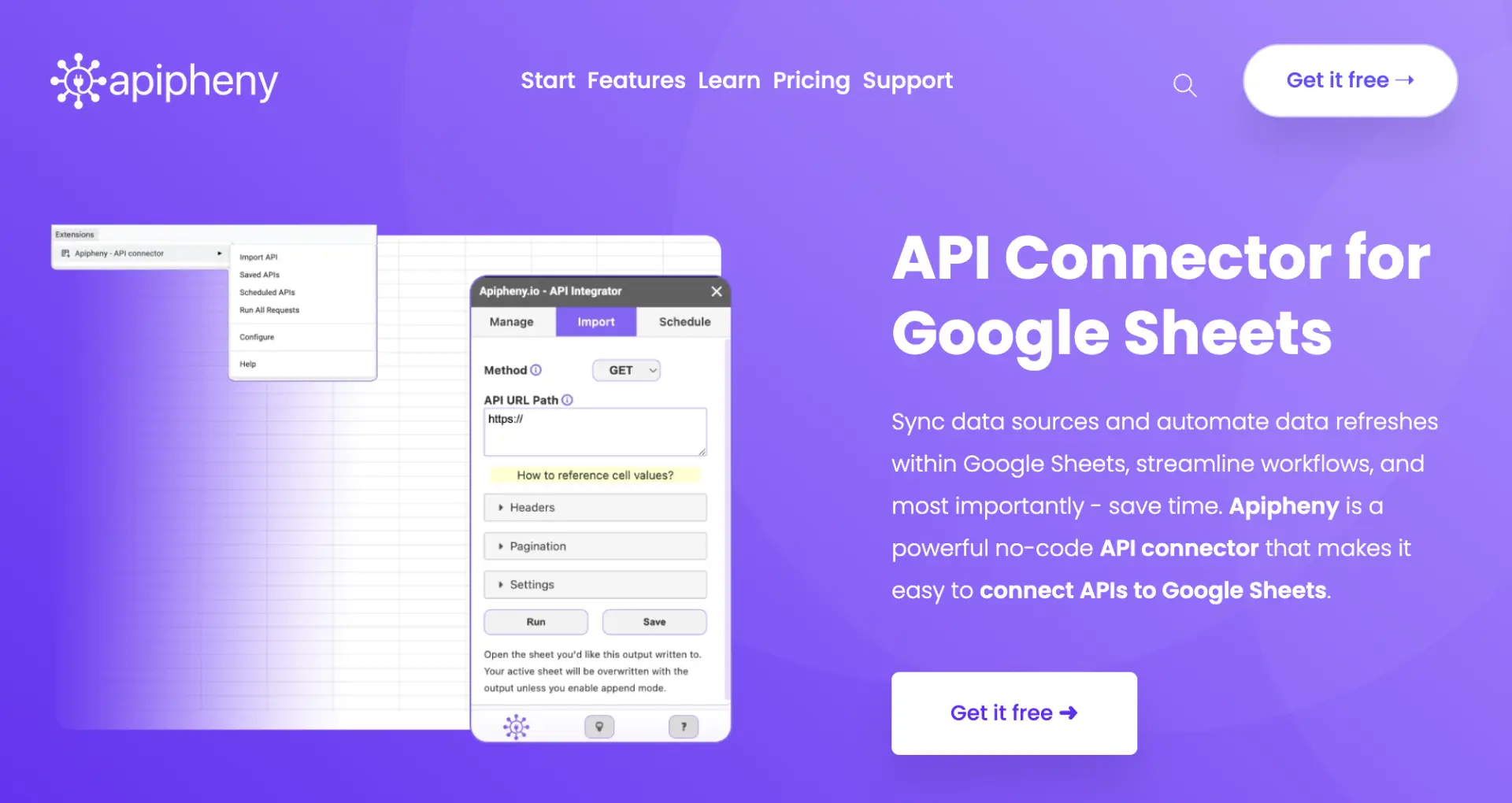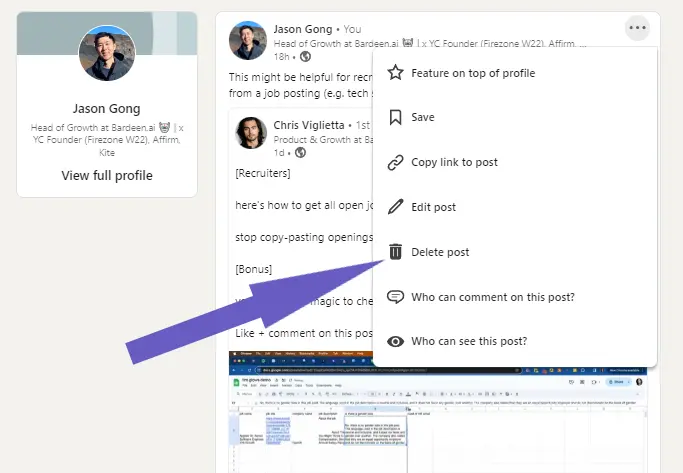





Open Google Sheets, use Apps Script, and run the importJSON function.
By the way, we're Bardeen, we build a free AI Agent for doing repetitive tasks.
If you're working with JSON data, you might find our integration with Google Sheets helpful. It automates JSON imports and saves you time.
In today's data-driven world, efficiently importing JSON data into Google Sheets is a crucial skill. Our comprehensive guide breaks down the process of converting JSON to Google Sheets, making it easy for you to work with data from various web services and APIs. Whether you're a beginner or an experienced user, this step-by-step tutorial will help you master JSON imports and streamline your data management tasks in 2024.
JSON (JavaScript Object Notation) is a lightweight data interchange format that has become the preferred choice for many modern web services and APIs. Its simplicity and ease of use make it an ideal format for exchanging data between different systems and platforms.
Here are some key reasons why JSON is widely adopted:
JSON's structure is based on two main elements:
These universal data structures, along with support for strings, numbers, booleans, and null values, make JSON highly versatile and suitable for representing complex data hierarchies. As a result, JSON has become the go-to format for data exchange in modern web development, enabling data enrichment and seamless integration between diverse systems and services.
Before you start importing JSON data into Google Sheets, there are a few prerequisites to ensure a smooth process:
Next, you'll need to enable the necessary APIs or scripts to facilitate the JSON import process. Here's how:

For a more advanced approach, you can also connect Google Sheets with other apps to enhance your data handling capabilities.
Bardeen can help you automate this process with a single click. Try it now to connect Google Sheets.

With the sheet prepared and the necessary APIs or scripts enabled, you're now ready to proceed with importing JSON data into your Google Sheet.
Google Apps Script is a powerful tool for automating tasks in Google Sheets, including importing JSON data. Here's a step-by-step guide on how to create and use a custom script for this purpose:

function importJSON(url, xpath, apiKey) { var response = UrlFetchApp.fetch(url, {'muteHttpExceptions': true}); var json = response.getContentText(); var data = JSON.parse(json); var pathArray = xpath.split("."); for (var i = 0; i < pathArray.length; i++) { data = data[pathArray[i]]; } return data; }=importJSON("url", "xpath", "apiKey"), replacing the arguments with your specific values.If your JSON data has a nested structure, you can modify the 'xpath' parameter to navigate through the hierarchy. For example, if your data is structured like {"results": {"data": [{"name": "John", "age": 30}, {"name": "Jane", "age": 25}]}}, you would use "results.data" as the 'xpath' to access the array of objects.
Remember to handle errors and exceptions in your script, especially when dealing with external data sources or APIs. You can use try/catch blocks and check for valid responses before parsing the JSON to ensure your script runs smoothly. Consider using tools to enrich LinkedIn profiles or bring AI into your spreadsheet for more advanced data handling.
While Google Apps Script provides a powerful way to import JSON data into Google Sheets, third-party tools and add-ons can streamline the process even further. These tools often require a subscription but offer user-friendly interfaces and additional features that enhance the JSON import experience.
Popular third-party tools for importing JSON into Google Sheets include:

Using Bardeen, you can automate the JSON import process into Google Sheets with just a few clicks, saving time and focusing on more important tasks.
The main advantages of using these third-party tools include:
However, there are some drawbacks to consider:
Ultimately, the choice between using a third-party tool or a custom script depends on your specific needs, technical skills, and budget. If you require a quick and easy solution and don't mind the cost, a third-party tool might be the best option. However, if you need more control and customization, or if you have the necessary coding skills, a custom Google Apps Script may be preferable.
When working with JSON data in Google Sheets, you may encounter complex structures with nested objects and arrays. These nested structures can make it challenging to import and manipulate the data effectively. However, there are techniques and tools available to help you handle these complex JSON structures seamlessly.
To deal with nested JSON objects and arrays when importing to Google Sheets, consider the following approaches:
When working with complex JSON structures, it's essential to have a good understanding of the data model and the relationships between different elements. This knowledge will guide you in determining the most suitable approach for parsing and importing the data into Google Sheets.
Here are some scripting tips and tool recommendations for parsing complex JSON data:
Remember to handle arrays within the JSON structure carefully. Determine whether you want to import each array element as a separate row or if you want to combine the array elements into a single cell. This decision will impact how you structure your parsing script or configure the flattening tool.
By applying these techniques and leveraging the appropriate tools, you can effectively handle complex JSON data and nested structures when importing into Google Sheets. This will enable you to work with a wide range of JSON data sources and scrape data from websites easily.
Manually importing JSON data into Google Sheets can be a time-consuming and repetitive task, especially if you need to update the data regularly. Fortunately, there are methods available to automate the process and keep your data in sync with the JSON source. Let's explore how you can set up automatic refreshes and data syncing between JSON sources and Google Sheets.
One approach to automate JSON data imports is to use Google Apps Script. By creating a custom script, you can fetch the JSON data from the desired source and update the corresponding sheet automatically. Here's a step-by-step guide:
To automate the execution of this script, you can set up triggers within the Google Apps Script environment. Triggers allow you to specify when and how often the script should run. For example, you can create a time-driven trigger that runs the script every hour or at a specific time each day. This ensures that your Google Sheet is automatically updated with the latest JSON data at regular intervals.
Automate your JSON data imports with ease by using Bardeen. Save time and focus on analyzing the data rather than manually importing it.
Another option for automating JSON data imports is to use third-party tools or add-ons specifically designed for this purpose. These tools often provide user-friendly interfaces and additional features to streamline the process. Some popular options include:
When setting up automated JSON data imports, consider the following best practices:
By automating JSON data imports into Google Sheets, you can save time, reduce manual effort, and ensure that your data is always up to date. Whether you choose to use Google Apps Script or leverage third-party tools, the ability to synchronize your sheets with JSON sources opens up a world of possibilities for data analysis and reporting.
When importing JSON data into Google Sheets, you may encounter various challenges and errors that can hinder the process. In this section, we'll identify some of the most common issues and provide solutions to help you troubleshoot and resolve them effectively.
One of the primary issues you might face is the "Error getting data" message when using custom functions like IMPORTJSON. This error often occurs due to API rate limits or server overload. To mitigate this problem, consider the following solutions:
Another common challenge is dealing with complex or nested JSON structures. When the JSON data has multiple levels of nesting or arrays within objects, it can be difficult to extract the desired information. Here are some tips to overcome this hurdle:
Inconsistent or invalid JSON formatting can also lead to import failures. To troubleshoot these issues:
In some cases, you might encounter issues related to data types or formatting. For example, date formats in the JSON data may not match the expected format in Google Sheets. To resolve such problems:
Lastly, network connectivity issues or firewall restrictions can prevent successful JSON imports. If you suspect this to be the case:
By following these troubleshooting tips and best practices, you can effectively resolve common issues encountered during JSON imports into Google Sheets. Remember to regularly monitor your import process, handle errors gracefully, and keep your scripts and tools updated to ensure smooth and reliable data integration. For more advanced integrations, you can also connect Google Docs to streamline your workflow further.










SOC 2 Type II, GDPR and CASA Tier 2 and 3 certified — so you can automate with confidence at any scale.
Bardeen is an automation and workflow platform designed to help GTM teams eliminate manual tasks and streamline processes. It connects and integrates with your favorite tools, enabling you to automate repetitive workflows, manage data across systems, and enhance collaboration.
Bardeen acts as a bridge to enhance and automate workflows. It can reduce your reliance on tools focused on data entry and CRM updating, lead generation and outreach, reporting and analytics, and communication and follow-ups.
Bardeen is ideal for GTM teams across various roles including Sales (SDRs, AEs), Customer Success (CSMs), Revenue Operations, Sales Engineering, and Sales Leadership.
Bardeen integrates broadly with CRMs, communication platforms, lead generation tools, project and task management tools, and customer success tools. These integrations connect workflows and ensure data flows smoothly across systems.
Bardeen supports a wide variety of use cases across different teams, such as:
Sales: Automating lead discovery, enrichment and outreach sequences. Tracking account activity and nurturing target accounts.
Customer Success: Preparing for customer meetings, analyzing engagement metrics, and managing renewals.
Revenue Operations: Monitoring lead status, ensuring data accuracy, and generating detailed activity summaries.
Sales Leadership: Creating competitive analysis reports, monitoring pipeline health, and generating daily/weekly team performance summaries.